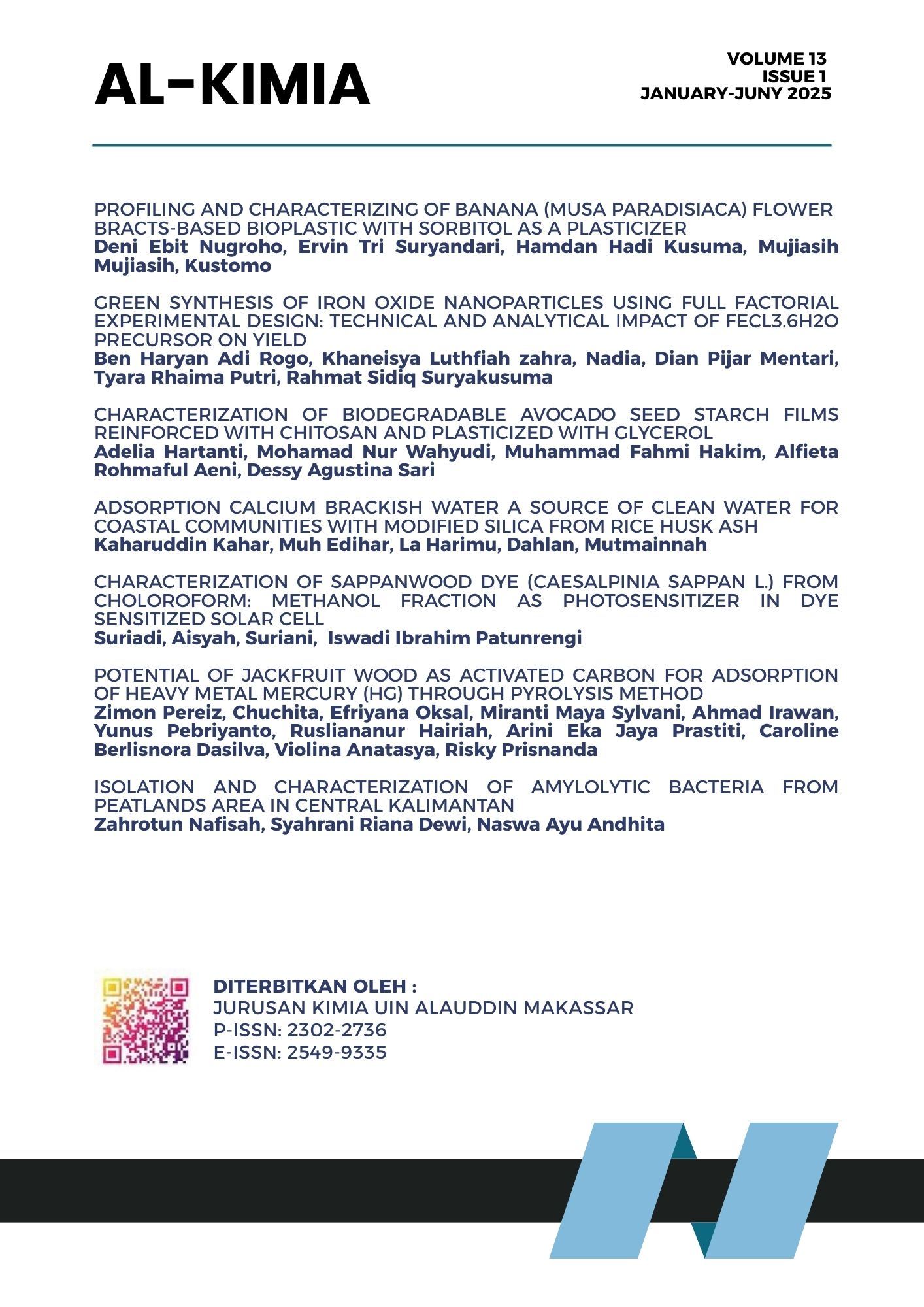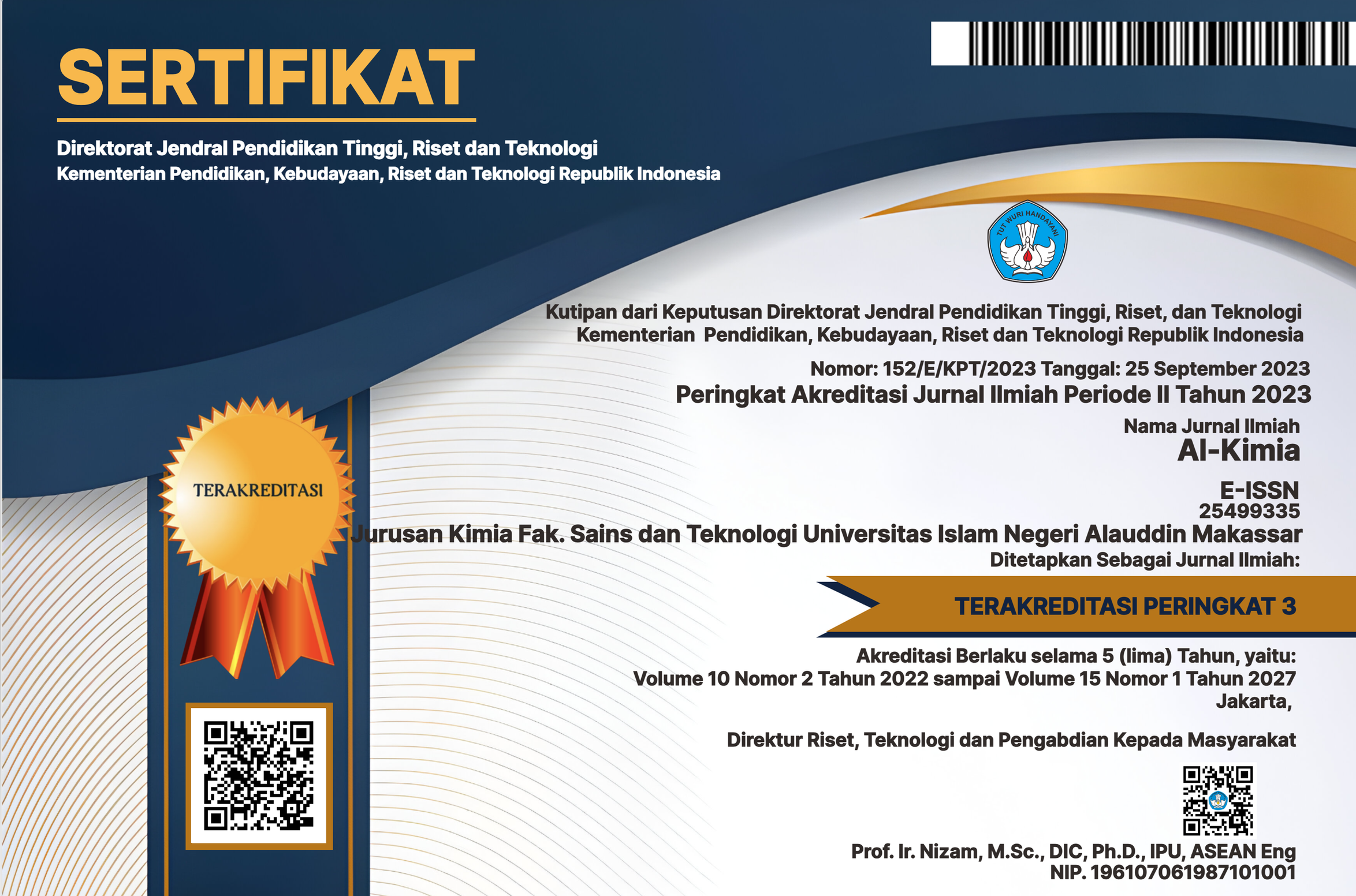Characterization of Sappanwood Dye (Caesalpinia sappan L.) from Choloroform:Methanol Fraction as Photosensitizer in Dye Sensitized Solar Cell
Keywords:
Characterizations, dye sensitised solar cell, sappanwoodAbstract
The electricity crisis in Indonesia is caused by the decreasing supply of fossil fuels for power plants. One solution to overcome this problem is the Dye-sensitized Solar Cell (DSSC) which can convert sunlight into electrical energy by utilizing environmentally friendly organic dyes. This study has succeeded in making and determining DSSC using organic dyes derived from sappanwood extract with pH variations (4, 7, and 10). Each pH level produces efficiency values of 0.01714%, 0.05497% and 0.03174%. VLC with a chloroform: methanol ratio (5:5 and 1:9) was then characterized using UV-Vis, FTIR, and GC-MS instruments. Characterization of sappanwood dye extract using UV-Vis instrument showed absorption at wavelengths of 243, 285, 445, and 541. FTIR instrument provided information on functional groups –OH at wave number 3415.93 cm-1 and C-O-C at wave number 1255.66 cm-1 which are characteristic of isoflavonoid compounds. In addition, GC-MS instrument indicated the possibility of fragment m/z 286 at retention time 9.54 is a brazilin
Downloads
References
Abidin, Z., Maulana, E., Mudjirahardjo, P., & Fadillah, M. I. (2020). Dye pH Variation on Blueberry Anthocyanin Based Dye Sensitized Solar Cell. Bulletin of Electrical Engineering and Informatics, 9(3), 950–955. https://doi.org/10.11591/eei.v9i3.1969
Akinsola, I. S., Alabi, A. B., & Nicola, C. (2021). Optical and Chemical Properties of Fragaria ananassa and Galena: Potential Photosensitizers in a Natural Dye-Sensitized Solar Cell. Tanzania Journal of Science, 47(5), 1508–1516. https://doi.org/10.4314/tjs.v47i5.2
Arsyad, W. S., Suhardiman, R., Usman, I., Aba, L., Suryani, S., Ramadhan, L. O. A. N., Nurdin, M., & Hidayat, R. (2024). Improvement of Dye-Sensitized Solar Cells (DSSCs) Performance Using Crude Brazilein Extract from Sappanwood (Caesalpinia Sappan L.) with the Incorporation of ZnO Nanoparticles. Journal of Molecular Structure, 1303, 137548. https://doi.org/https://doi.org/10.1016/j.molstruc.2024.137548
Boyo, A. (2020). Dye Sensitized Solar Cells Based on Commelino nudiflora as Sensitizer. Journal of Research and Review in Science, 7(1), 68–74. https://doi.org/10.36108/jrrslasu/0202.70.0101
Ekpunobi, U. E., Ogbuefi, S. I., & Ekpunobi, A. J. (2022). Dye pH Effect on Photoelectric Parameters of Natural Photosensitizer Pigment Extracted from Alstonia boonei for Dye-Sensitized Solar Cells. International Journal of Energy Research, 46(2), 1922–1933. https://doi.org/https://doi.org/10.1002/er.7307
Ferreira, B. C., Sampaio, D. M., Suresh Babu, R., & de Barros, A. L. F. (2018). Influence of nanostructured TiO2 film thickness in dye-sensitized solar cells using naturally extracted dye from Thunbergia erecta flowers as a photosensitizer. Optical Materials, 86, 239–246. https://doi.org/https://doi.org/10.1016/j.optmat.2018.10.016
Furniss, B. S., Hannaford, A. J., Smith, P. W. G., & Tatchell, A. R. (1989). VOGEL’s Practical Organic.
Grätzel, M. (2001). Electrochemical Cells. Nature, 414(6861), 338–344. https://doi.org/10.1038/35104607
Gu, Y., Wang, T., Dong, Y., Zhang, H., Wu, D., & Chen, W. (2020). Ferroelectric polyoxometalate-modified nano semiconductor TiO2 for increasing electron lifetime and inhibiting electron recombination in dye-sensitized solar cells. Inorganic Chemistry Frontiers, 7(17), 3072–3080. https://doi.org/10.1039/D0QI00488J
Downloads
Published
Versions
- 2025-07-30 (2)
- 2025-06-29 (1)
How to Cite
Issue
Section
License
Authors who publish with this journal agree to the following terms:
1) Authors retain copyright and grant the journal right of first publication with the work simultaneously licensed under a Creative Commons Attribution License that allows others to share the work with an acknowledgement of the work's authorship and initial publication in this journal.
2) Authors are able to enter into separate, additional contractual arrangements for the non-exclusive distribution of the journal's published version of the work (e.g., post it to an institutional repository or publish it in a book), with an acknowledgement of its initial publication in this journal.
3)Authors are permitted and encouraged to post their work online (e.g., in institutional repositories or on their website) prior to and during the submission process, as it can lead to productive exchanges, as well as earlier and greater citation of published work (See The Effect of Open Access).



